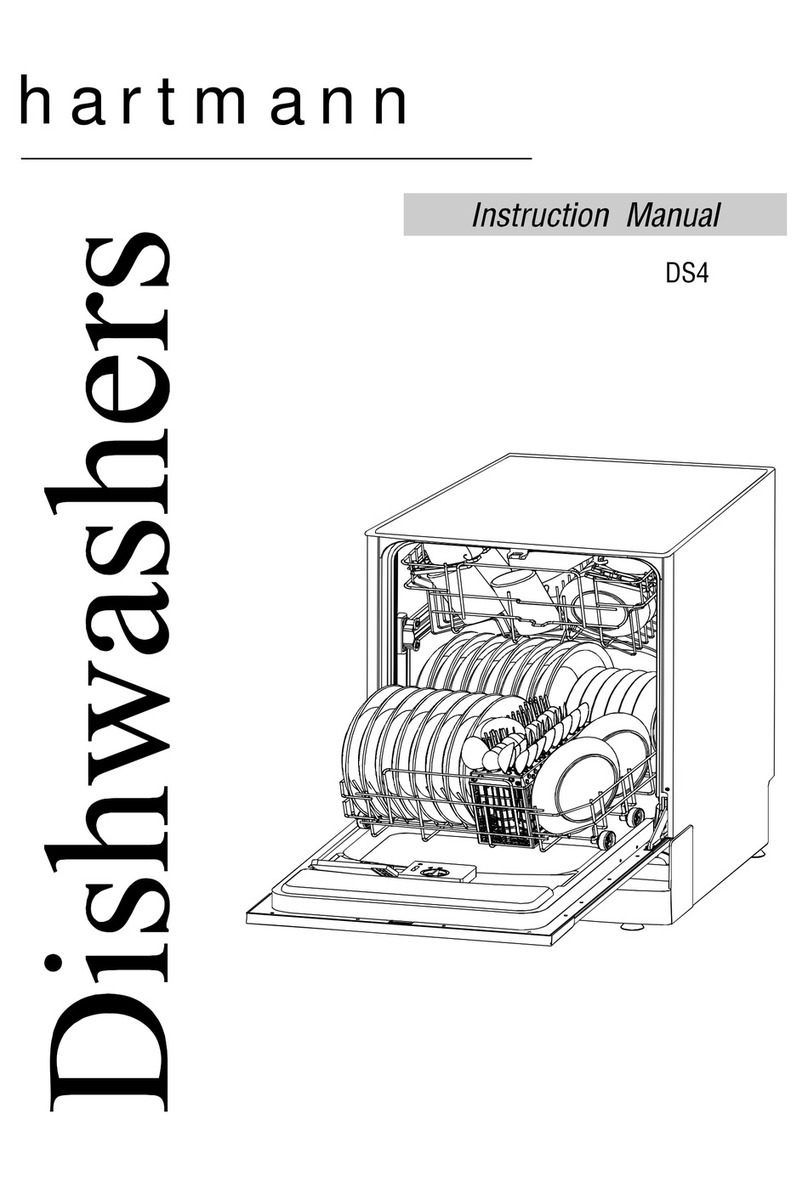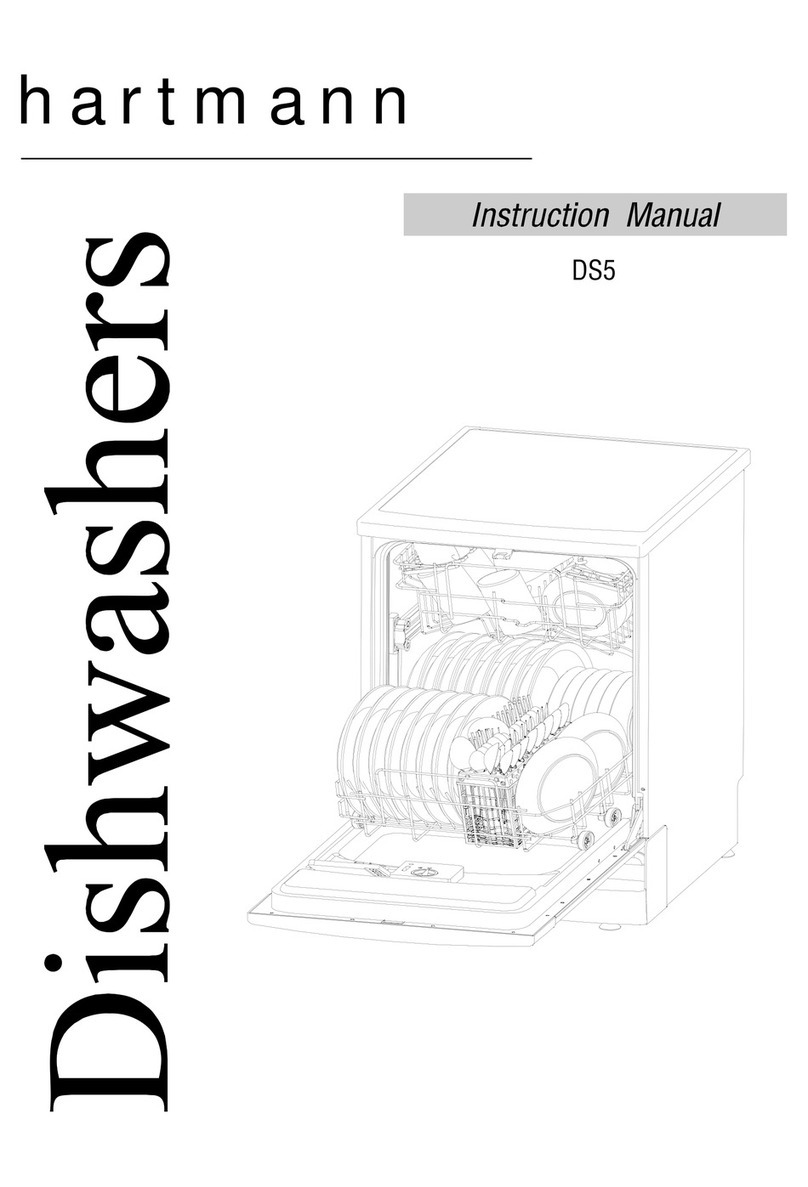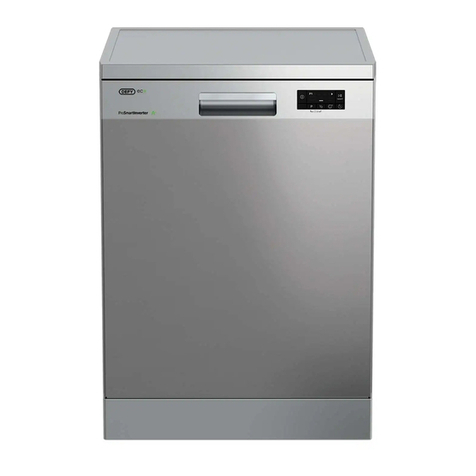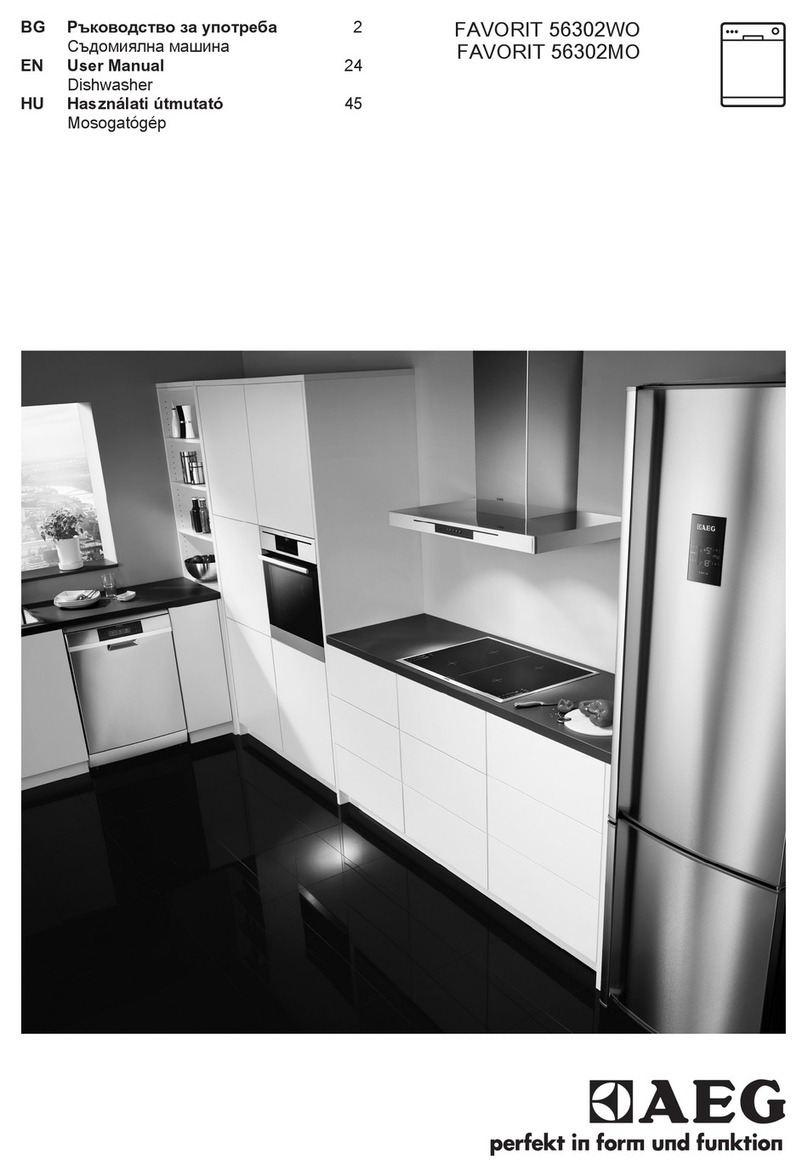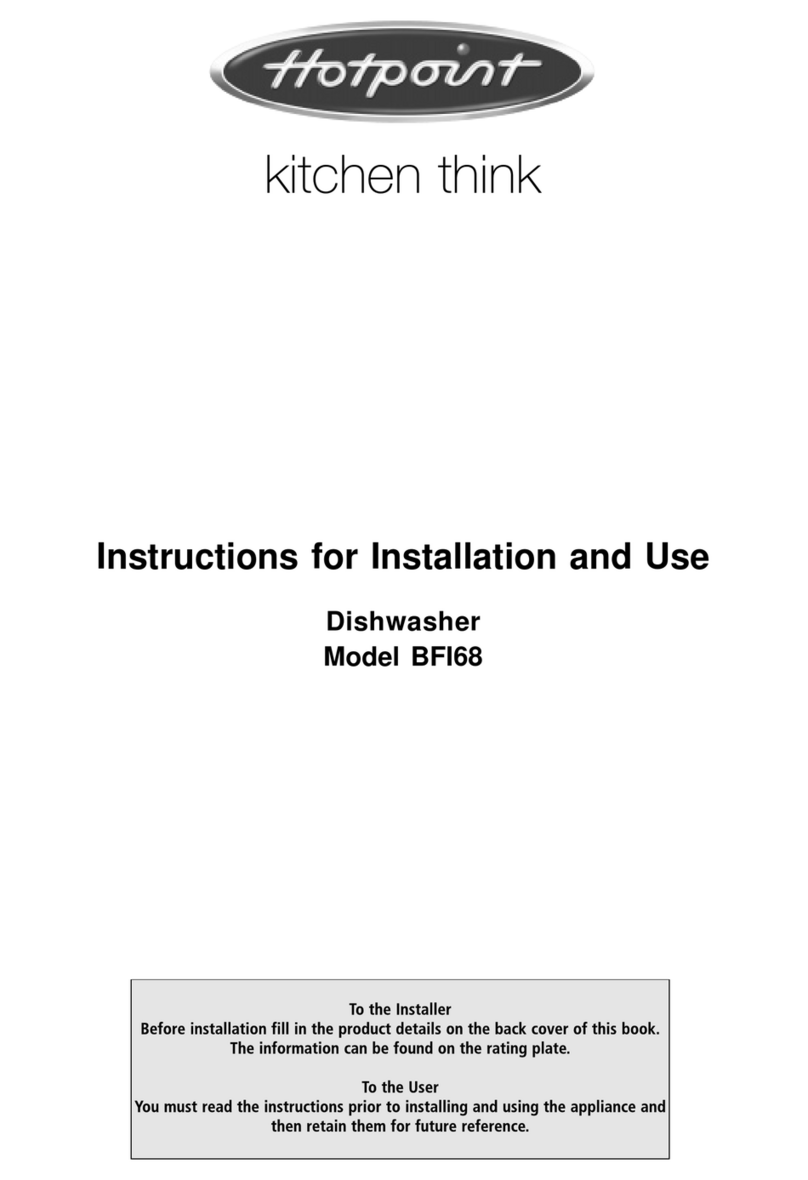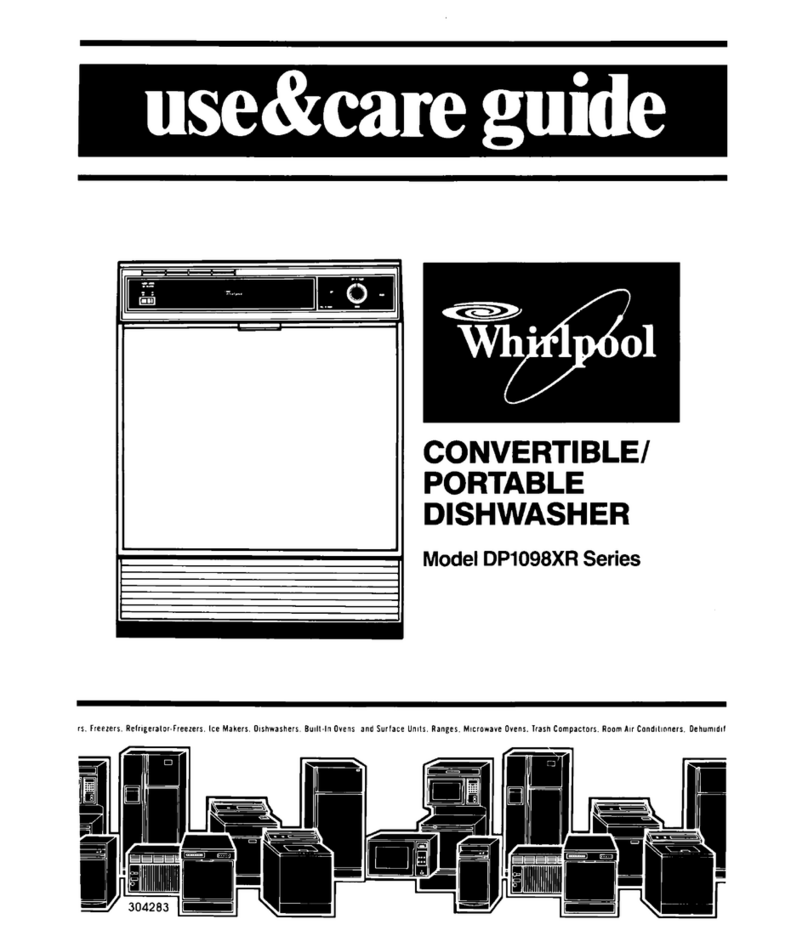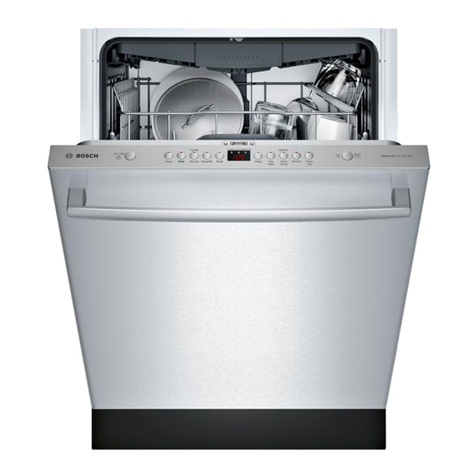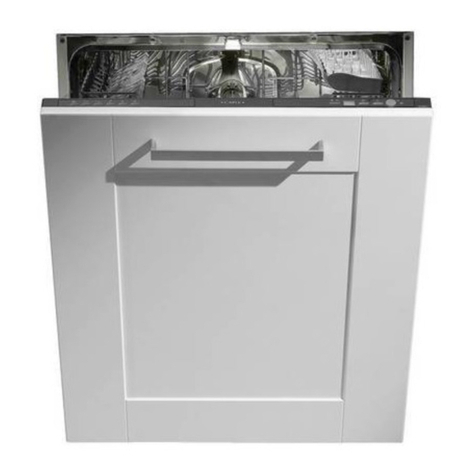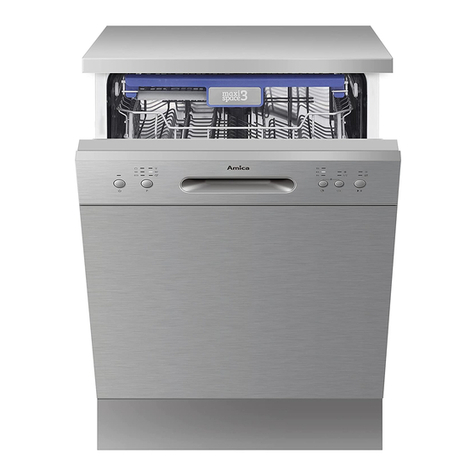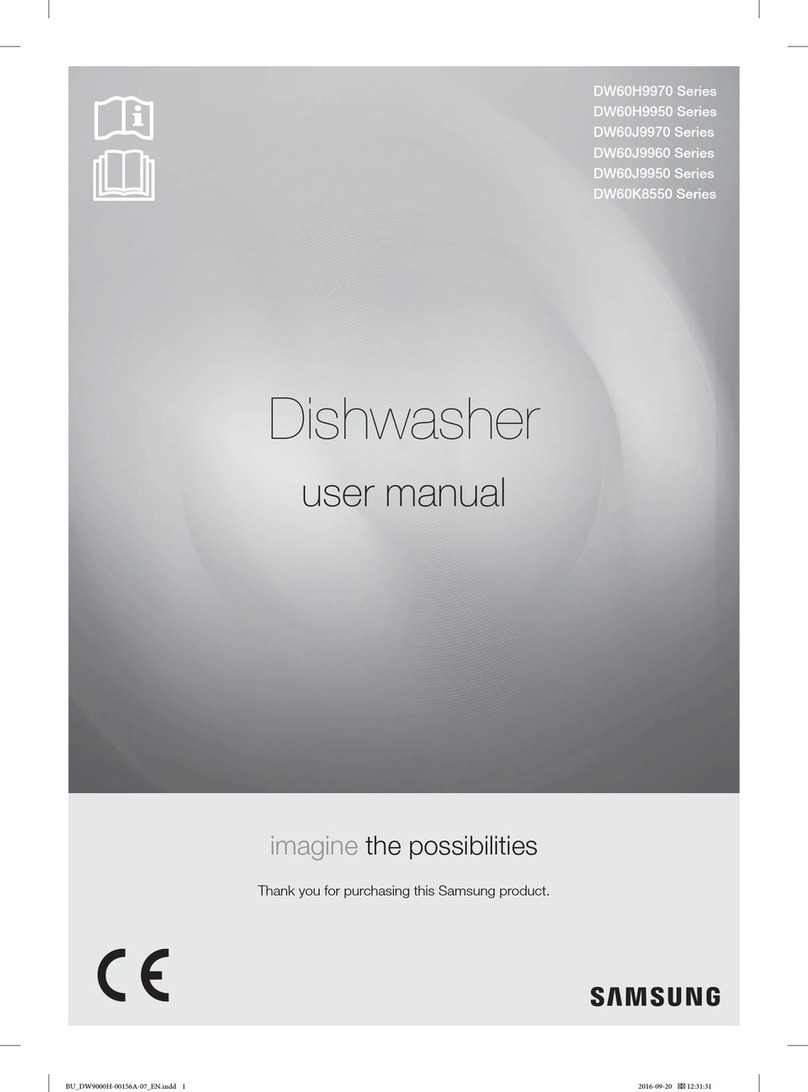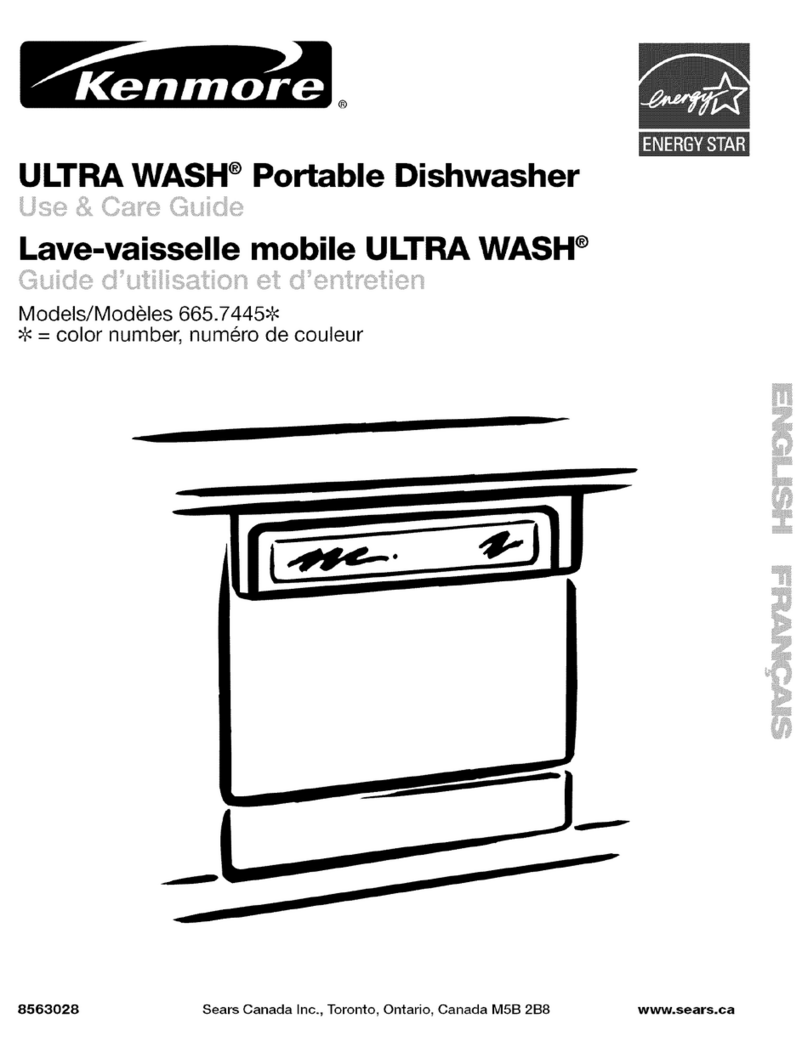Hartmann DS6 User manual

DS6
hartmann

Compartment
Fill main-wash detergent.
Compartment
Fill pre-wash detergent.
(Follow the user instructions!)
Mechanical indicator
Check the rinse aid level
Load the baskets
Select a programme
Close the door, turn on the water tap and press the Start/Reset button. The machine will start working
after about 10 seconds.
Running the dishwasher
Switch off the appliance
Turn off the water tap,
unload the baskets
Fill the detergent dispenser
Warning: wait a few minutes (about 15 minutes) before unloading the dishwasher to avoid handling
the dishes and utensils while they are still hot and more susceptible to break.
They will also dry better. Unload the appliance, starting from the lower basket.
Scrape off any large amount of leftover food. Soften remnants of burnt food in pans,
then load the baskets. Refer to the dishwasher loading instructions.
Press the Programme button until the selected programme lights up.
( See the section entitled Operationg instruction )“”
When the working cycle has finished, the buzzer of the dishwasher will sound 8 times, then stop.
Turn off the appliance using the ON/OFF button.
Switch on the appliance Press the On/Off button to switch on the appliance, Open the door.
Electric indicator on control panel (if provided).
For detailed operating method read the corresponding content onthe instruction manual.
Changing the programme
Add forgotten dishes in the
dishwasher.
If the appliance is switched
off during a wash cycle.
Open the door carefully.
Hotsteam may escape
when thedoor isopened!
If the appliance is switched off during a wash cycle, when switched
on again, please re-select the washing cycle and operate the dishwasher
according to the original Power-on state ).
1.Open the door a little to stop the dishwasher.
2.After the spray arms stop working, you can open the door completely.
3.Add the forgotten dishes.
4.Close the door, the dishwasher will start running again after 10 seconds.
1. Arunning cycle can only be modified ifit has been running for a short time. Otherwise the detergent
may have already been released and the water already drained. If this is the case, the detergent
dispenser must be refilled.
2. Press the Start/Reset button for more than 3 seconds to cancel the running programme.
3. Select a new programme.
4. Restart the dishwasher.

To review the section on troubleshooting Tips
will help youto solve some common problems
by yourself .
Dear Customer,
Please carefully read this manual beforeusing the
dishwasher, it will help you to use and maintain the
dishwasher properly.
Pass it on to anysubsequentowner of the appliance.
This manual contains sections on safety Instructions,
OperatingInstructions,InstallationInstructionsand
Troubleshooting Tips, etc.
The manufacturer, following a policy of constant
development andupdating of the product, may
make modifications without giving prior notice.
Keep it to refer to it at a later date.
If you can not solvethe problems by yourself ,
please ask for the help of professional technicians.
Dishwasher Features.......................................2
Attention before or after loading the Dishwasher
Baskets..........................................................6
Filtering System.............................................11
Caring forthe Dishwasher..................... .........12.
A Fill the RinseAid Dispenser............. .. ..3、..... ...
B FunctionofDetergent .........................4、........
Loadingthe upper ................ ..............7Basket ...
Loading the Lower ...................... .........7Basket ..
Cutlery Basket................................................8
WashCycleTable...........................................9
Turning ontheAppliance................................10
Change the Programme.............. ................10....
At the Ene of the Wash Cycle...........................10
Positioning the Appliance................... ..........13..
Water Connection.................................. .......14.
About Power Connection........................ .......13.
Startof dishwasher................................ ......15..
Before calling for service........................... .....16.
Errorcodes.................................... ..............17.
Technical information.............................. .....18..
Control Panel...................................................2

1
This appliance must be grounded. In the event of a
malfunction or breakdown, grounding will reduce
the risk of anelectric shock by providing a path of
least resistance of electric current. This appliance
is equipped with a cord having an equipment-
grounding conductor and a grounding plug.
The plug must be plugged into an appropriate outlet
that is installed and grounded in accordance with
all local codes and ordinances.
Improper connection of the equipment-grounding
conductor can result in the risk of an electric shock.
Check with a qualified electrician or service
representative if you are in doubt whether the
appliance is properly grounded. Do not modify the
plug provided with the appliance; If it does not fit
the outlet. Have a proper outlet installed by a
qualified electrician.
Under certain conditions, Hydrogen gas may be produced in a hot-water system that has not been
used for two weeks or more. HYDROGEN GAS IS EXPLOSIVE.
If the hot-water system has not been used for such a period oftime, before using the dishwasher turn
on all the hot-water taps and let the water flow from each of them for several minutes. This will release
any accumulated hydrogen gas.As the gas isflammable, do not smoke oruse an open flame during
thistime.
Keep children away from detergent and rinse aid, keep
child away from the open door of the dishwasher,
there could still be some detergent left inside.
ren
Do not abuse, sit on, or stand on the door or dish
rack of the dishwasher.
Do not touch the heating element during or
immediately after use.
(This instruction is only applicable to machines
with a visual heating element.)
Do not wash plastic items unless they are marked
dishwasher safe or the equivalent. For plastic items
not so marked, check the manufacturer's
recommendations.
Use only detergent and rinse additives
designed for an automatic dishwasher.
Never use soap, laundrydetergent, or hand
washing detergent in your dishwasher. Keep
these products out of the reach of children.
During installation,the powersupplymustnot
be excessivelyordangerouslybentorflattened.
Do not tamper with controls.
Do not operate your dishwasher unless all
enclosure panels are properly in place. Open
the door very carefully if the dishwasher is
operating, there is a risk of water squirting out.
Do not place any heavy objects the
door when it is open. The appliance could tip
forward.
on or stand on
When loading items to be washed:
1) Locatesharp itemsso that theyarenot likely
todamagethedoorseal;
2 Warning: Knives and other utensils with
sharp points must be loaded in the basket
with their pointsdown or placedin a
horizontalposition.
)
When using your dishwasher, you should
prevent plastic items from cominginto contact
withthe heating element.(This instruction is only
applicable to machines with a visual heating
element.)
If the supply cord is damaged, it must be replaced
by themanufacturer or itsservice agent ora
similarly qualified person in order to avoid a
hazard.
Please dispose of packing materials properly.
Use the dishwasher only for its intended function.
Remove the door tothe washing compartmentwhen
removing an old dishwasher from service or discarding it.
Dishwasher detergents are strongly alkaline, they
can be extremely dangerous if swallowed.Avoid
contact with skin and eyes and keep children away
from the dishwasher when the door is open.
Check that the detergent comparment isempty
after completion of the wash cycle.
The applianceis to be connected to the water
mains using new hosesets and that old hose-sets
should not be reused.
The maximumnumber of place settings tobe
washed is12.
The maximumpermissibleinletwater pressureis
1Mpa.
The minimum permissibleinlet water pressureis
0.04Mpa.
Children should be supervised to ensure that they do
not play with the appliance.
This appliance is not intended for use by persons
(including children with reduced physical, sensory or
mental capabilities, or lack of experience and
knowledge ,unless they have been given supervision
or instruction concerning use of the appliance by a
person responsible for their safety.
)
When using your dishwasher, follow the precautions listed below:
The door should not be left open,
since this could increase the risk of tripping.

10 11
Back View
Front view
2
MainFilter
DetergentDispenser
Cup Shelf
CutleryBasket
CoarseFilter
Rinse Aid Dispenser
Inlet pipe connector
Drain pipe connector
Lower Basket
SprayArms
Upper Basket
15
6
7
8
9
10
11
3
24
1
2
3
4
5
6
7
8
9
Rrinse aid warning lights: To come on when the
rinse aid dispenser needs to be refilled.
before using it for the first time.
To get the best performance from yourdishwasher, read all operating instructions
Start andresetbutton: Tostart and pausethe
selected washing program or reset the washing
program when the machine isworking.
Washing Program Selector : Turn the knob to
select wash cycles .
65
6
4
5
All in 1 function button and indicator light : The indicator
light will be on when you select this function.
Power indicator light and switch: To turn on/off
and showthe power supply.
Running indicator light : To show the state of the
dishwasher.
4
2
3
2
3
Rapid

Before using your dishwasher for the first time:
3
A. Fill the rinse aid dispenser
B. Fill indetergent
The rinse aid is releasedduring the final rinse to prevent water from forming droplets onyour dishes, which can leave
spots andstreaks. It also improvesdrying by allowing water to roll off the dishes.Your dishwasher is designed to
useliquid rinseaids.The rinse aiddispenser islocated inside thedoor next tothe detergent dispenser. To fill the
dispenser,open thecapand pour the rinse aidintothe dispenseruntil thelevel indicatorturnscompletelyblack.
The volume of the rinse aid container is about 110ml.
RinseAid Dispenser
Function of RinseAid
Rinse aid is automatically added during the last rinse, ensuring thorough rinsing, and spot and streak free drying.
Attention!
Only use branded rinseaid for dishwasher. Neverfill therinse aid dispenser withanyother substances
(e.g. Dishwasher cleaning agent, liquid detergent).This would damage the appliance.
To openthe dispenser, turn the cap to the "open" (left) arrow and lift it out.
Pour the rinse aid into the dispenser, being careful not to overfill.
Replace the cap by inserting it aligned with "open" arrowand turning it to the closed (right)arrow.
1
2
3
As the rinse aid diminishes, the sizeof the black dot
on the rinse aid level indicator changes, as illustrated below.
Full
3/4full
1/2full
1 / 4full - Should refill to eliminate spotting
Empty
When to Refill the RinseAid Dispenser
If thereis norinse-aid warning light inthecontrol panel, you can estimate the amount from thecolour
of the optical level indicator C located next tothe cap. When the rinse-aid container is full, the whole
indicator will be dark.Astherinse-aiddiminishes,the sizeof the dark dot decreases.You shouldnever let
therinse aidlevel fall 1 /4 full.
during thenext wash.
Don't forgetto replace the cap before you close dishwasher door.
Cleanup any rinse aid spilledwhile during filling with anabsorbentclothto avoid excessivefoaming
""

4
Adjusting RinseAid Dispenser
The rinse aid dispenser has six or four settings. Always start with the dispenser
set on "4". If spots and poor drying are a problem, increase the amount of rinse
aid dispensed by removing the dispenser lid and rotating the dial to "5". If the
dishes still are not drying properly or are show spots, adjustthe dial to the next
higher lever until your dishes are spot-free. The recommended setting is "4".
(Factory valueis "4".)
Increase the dose if thereare drops of wateror limespotsonthe dishes after washing.
Reduce itifthere are sticky whitish stains on your dishes or abluish film on glassware or
knife blades.
Detergents with its chemical ingredients arenecessary to remove dirt,crush dirt and transport it outof the dishwasher.
Use only detergent specifically made for the use in dishwashers.
Detergents
Thereare 3 sorts of detergents
1.Withphosphate andwithchlorine
2.With phosphate and without chlorine
3.Without phosphate and without chlorine
Based ontheir chemical composition, detergents can besplit in two basic types:
The use of normal washingprograms incombination with concentrated detergents
reduces pollution and is good for your dishes; these wash programs are specifically matched
to the dirt-dissolving properties of the enzymes of the concentrated detergent. For this reason
normal wash programsin which concentrated detergents are used canachieve the same
results that canotherwise onlybe achievedusing intensive programs.
“”
“”
“”
Detergenttabletsof different brands dissolve at different speeds. For this reasonsome
detergenttablets cannot dissolve and develop their fullcleaning power during short
programs. Therefore please use long programs whenusingdetergent tablets, to
ensure the complete removal of detergent residuals.
The dispenser must be refilled before the start of each wash cycle following the instructions
provided in the wash cycle table . Your dishwasher uses less detergent and rinse aid than
Conventional dishwasher.Generally, only one tablespoon of detergent is needed for
anormal washload. More heavily soileditems needmore detergent.Alwaysaddthe
detergent justbefore starting the dishwasher, otherwise it couldget damp and will not
dissolve properly.
Concentrated Detergent
DetergentTablets
DetergentDispenser
conventional, alkaline detergentswith caustic components
low alkaline concentrated detergents with natural enzymes
Normally new pulverised detergent is without phosphate.Thus the watersoftener function of
phosphate is not given. In this case we recommend to fill salt in the salt container even when
the hardness of water is only 6 dH. If detergents without phosphate are used in the case of hard water
often white spots appear on dishesand glasses. In this case please add more detergent to reach
better results. Detergents without chlorine do only bleach a little. Strong and coloured spots will not
be removed completely. Inthiscase please choose a program with a higher temperature.
°

Amount ofDetergentto Use
Proper Use of Detergent
Use only detergentspecificallymade for the use in dishwashers. Keep your detergentfresh and dry.
Don'tputpowdereddetergent into the dispenseruntil you'reready towash dishes.
Dishwasher detergent is corrosive! Take care to keep it out of reach of children.
Always add the detergent just before starting each wash cycle.
Only use branded detergent aidfor dishwasher.
If the lid is closed: press release button.The lid will spring open.
5
Detergent tablet
Detergent powder
Fill the detergentdispenser with detergent.
The marking indicates the dosing levels , as
illustratedontheright:
The placeof mainwash cycle detergent placed.
The place of pre-wash cycle detergent placed.
Pleaseobserve themanufacturersdosing andstorage
Recommendations as stated on the detergent packaging.
Close the lid and press untilitlocks in place.
If the dishes are heavily soiled, place an additional
detergentdose in the pre-wash detergent chamber.This detergentwilltake effect during the pre-wash phase.
A
B
Fill in Detergent
You find information about the amount of detergent for the single programme on the last page.
Please aware, that according to the level soiling and the specific hardness of water differences are possible.
Please observe the manufacturer's recommendations on the detergent packaging.

Cutlery with wooden,horn china or
mother-of-pearl handles
Plastic items that are not heat resistant
Older cutlery with glued parts that are not
temperatureresistant
Bonded cutlery items or dishes
Pewter or cooper items
Crystal glass
Steel items subject to rusting
Wooden platters
Items made fromsyntheticfibres
Some types of glasses can become
dull aftera large number of washes
Silver and aluminum parts have a
tendencyto discolourduring washing
Glazed patterns may fade if machine
washed frequently
Are not suitable Are oflimited suitability
Dishes and items of cutlery mustnot lie insideoneanother, or cover eachother.
To avoid damage to glasses, they must not touch.
Load large itemswhich are most difficult to cleaninto the lower basket.
The upper basket is designed tohold more delicate and lighter dishware such as glasses, coffee
andteacups
Long bladed knives stored in an upright position are a potential hazard!
Long and/or sharp items of cutlery such as carving knives must be positioned
horizontallyin the upperbasket.
Please do not overload your dishwasher. This is important forgood results and for
reasonable consumption of energy.
Load hollow items such as cups, glasses, pans etc. With the opening facing downwardsso that
water cannot collect in the container or a deep base.
Usea mild detergentthatis describedas 'kind todishes'.If necessary, seek further
information fromthedetergentmanufacturers.
Forparticular items, select aprogramwithaslow atemperature aspossible.
To prevent damage, take glass and cutlery out of the dishwasher as soon as possible
after the program has ended.
Consider buyingutensils which are identifiedas dishwasher-proof.
(For best performance of the dishwasher, follow these loading guidelines.
Features and appearance of baskets and cutlerybasketsmay vary from your model.)
Scrape off any large amounts of leftover food. Soften remnants of burnt food in pans.
It is not necessary to rinse the dishes under running water.
Place objects in the dishwasher in following way:
1.Items such as cups, glasses, pots/pans, etc. are faced downwards.
2.Curved items, or ones with recesses, should be loaded aslant so that water can run off.
3.All utensils are stacked securely and can not tipover.
4.All utensils are placed in the way that the spray arms can rotate freely during washing.
Very small items should not be washed in the dishwasher as they could easily fall out of the basket.
To prevent water dripping from the upper basket into the lower basket, we recommend that you
empty the lower basket first and then the upper basket.
6

7
The upperbasket isdesigned to hold more delicate andlighter dishwaresuchasglasses,coffee
and tea cups and saucers, as well as plates, small bowls and shallow pans (as long as they are
not toodirty).
Position the dishes and cookware so that they will not be moved by the spray of water.
Wesuggest that you place largeitems and items that arethemost difficult toclean into the lower basket
such as: pots,pans, lids, serving dishesandbowls,as shown inthefigurebelow.
It is preferableto placeservingdishes and lids onthe side of theracks inorder toavoid blocking the rotation ofthe
topspray arm.
Pots, serving bowls, etc, must always be placed top down.
Deep pots should be slanted to allow water to flow out.
Please be reminded that:
The Bottom Basket features folding spikes so that larger or more pots and pans can be loaded.
2
Glasses
1
Cups Saucers
3
6
Soup plates
5
Dinner plates
Dessertdishes
Cutlery basket
7
4
Saucers
3

8
Cutlery should be placed in the cutlery basket with the handles at the bottom. If the rack has side baskets, the
spoons should be loaded separately into the appropriate slots, especially long utensils should beplaced in the
horizontalposition at the frontof the upper basket as shown in the picture.
Folding Spikes of Lower Basket
For better stacking of pots and pans,
the spikes can be folded down as
show in the picture right.
Do not let any item extend through the bottom.
Always load sharp utensils with the sharp point down!
Adjusting the Upper Basket
The height of the upper basket can be adjusted in order to create more space forlarge utensils
both for the upper/lower basket. The height of the upper basket can be adjusted by placing the
wheels on different height of the rails. Long items, serving cutlery, salad servers and knives
should be placed on the shelf so that they do not obstruct the rotationof the sprayarms.
The shelf can be folded back or be removed when notrequired for use.
Upper wheels
Lower wheels
Teaspoons
4
Soup spoons
2
Forks
1
Knives
5
3
Dessert spoons
Forpersonal safety and a top qualitycleaning,place thesilverware inthebasket
making sure that:
Theydonotnesttogether.
Silverware is placed with the handles-down.
But place knives and other potentially dangerous utensils are placed handles-up.
4
42
4
4
4
4
4
4
4
1
1
1
1
1
1
1
1
1
4
4
4
1
1
1
5
5
5
5
5
5
5
5
5
5
5
5
2
2
2
2
2
2
2
2
2
2
2
3
3
3
3
3
3
3
3
3
3
3
3

9
Means: need to fill rinse into the Rinse-Aid Dispenser.
()
* : This program is the testcycle. The information for comparability test
in accordance with , as follows:
AS/NZS 2007.1
AS/NZS 2007.1
Capacity: 12 setting
Position Upper basket: upper wheels onrails
Rinse aid setting: 6
Open the door slightly 50mm to assist indrying of the dishes after every wash
Starting a cycle wash
Draw out the lower and upper basket, load the dishesand push them back.
It is commendedtoloadthe lower basket first,then the upperone (seethe sectionentitled
Loading the Dishwasher ).
Pour in thedetergent (see the section entitled Salt, Detergent and RinseAid ).
Insert the plug into the socket. The power supply is 220-240 VAC /50 HZ, the specification of the
socketis10A 250VAC. Make sure that the water supply is turned on tofull pressure.
Close the door,press the ON/OFF button, andthe ON/OFF light will turn on. Press the program
button to select a desired wash cycle. Then press the Start/Pause button to start themachine.
“”
“”
1
2
3
4
For normally soiled loads,
such as plates, glasses,
bowls and normally
soiledpans.
Ashorterwash for lightly
soiledloadsthat donot
needdrying.
Wash (55 )
Rinse
Rinse
Rinse (50 )
Drying
℃
℃
Wash (40 )
Rinse
Rinse (45 )
℃
℃
5/25 g.
(OrAllin1)
20 g.
110
30
12
12
0.82
0.5
(*AS/NZS 2007.1)
Normal
Rapid
Forheavilysoiledloads,
such as pots, plates, glasses
and lightly soiled pans.
standard daily cycle.
Pre-wash(50 )
Wash (50 )
Rinse
Rinse (65 )
Drying
℃
℃
℃
5/25 g.
(OrAllin1) 160 151.3
Heavy

10
It is dangerous to open the door when washing, because the hot water may scald you.
When the working cycle has finished, the buzzer of the dishwasher will sound for 8 seconds, then stop. Turn off
the appliance using the ON/OFF button, shut off the water supply and open the door of the dishwasher.
Wait for afew minutesbefore unloading the dishwasher toavoidhandling the dishes and utensils while they
are still hot and more susceptible to breakage. They will also dry better.
Switch Off the Dishwasher
The running indicator lightis off, only in this case the programme has ended.
1.Switch off the dishwasher by pressing the ON/OFF button.
2.Turnoffthewater tap!
Open the door carefully.
Hot dishes are sensitive to knocks. The dishes should therefore be allowed to cool down around 15 minutes
before removing from the appliance.
Open the dishwasher's door, leave it ajar and wait a few minutes before removing the dishes. In this way they
will be cooler and the drying will be improved.
Unloadingthedishwasher
It is normal that the dishwasher is wet inside.
Empty thelower basket first and then the upper one.This will avoid water dripping from the upper Basket onto
the dishes in the lower one.
If you open the door , the machine will pause. The running indicator
light will stopblinkingand the buzzer willmooing every minute unless you close the door .
After you close the door ,the machine will keep on working after 10 seconds.
during a washcycle
Aforgotten dish can be added any time before the detergent cup opens.
Add forgotten dishes.
Close the door
After the spray arms stop working,you can open the door
completely.
2
3
Open the door a little to stop the washing.
14
5
6
Press the start/reset button
Press the start/reset button, the dishwasher will run
after 10 seconds.
When you press the Start/Reset button to pause during washing, the running indicator
light will stop blinking and the dishwasher will mooing every minute unless you press the
Start/Reset button to start.
Acycle that is underway can only be modified if it has only been running for a short
time. Otherwise, thedetergent may have alreadybeen released, and the appliancemay
have already drained the wash water. If this is the case, the detergent dispenser must
be refilled (see the section entitled " Loading the Detergent " ).
When you press thestart/reset button more than 3 seconds, you can cancel the running
programme andselect otherprogrammes (see the sectionentitled "Starting awash cycle. .. " ).
When you select Heavy/Normal.Programmes, you can select theAllin1 function.
The Display window shows the state of the dishwasher:
a) Running indicator lightis off ----------------------------------> stand by;
b) Running indicator light is on and not blinking -------------> pause;
c) Running indicator light is on and blinking ------------------------> run.
1
2
3
4
Premise

The filter prevents larger remnants of food or other objects from getting inside the pum.
Theresidues may blockthefilter, inthis casethey must be removed.
The filter system consists of a coarse filter,a flat (Main filter)
Anda microfilter(Fine filter).
Food and soil particles trapped inthisfilter arepulverizedby a
special jet on the lower spray arm and washed down todrain.
Larger items, such as piecesof bones or glass, that could block
the drainaretrappedin the coarse filter. To removethe items
caught by the filter, gently squeeze the tap on the top of this
filterandliftout.
Thisfilter holds soil and food residues in the sumpareaand
preventsitfrom being redepositon the dishes during washcycle.
Main filter
1
Coarse filter
2
Fine filter
3
2
3
1
Filter assembly
Thefilter efficiently
For best performance and results, the filter must be cleaned regularly. this reason, it is a good idea to
remove the larger food particles trapped in the filter aftereach wash cycleby rinsing the semicircular filter and
cup under running water. To remove the filter device, pull the cup handle in the upward direction.
removes food particles from the wash water, allowing it to be recycled during the cycle.
For
The dishwasher must never be used without the filters.
Improper replacementof the filter may reduce the performance level ofthe appliance
and damage dishesand utensils.
11
When following this procedure from step1 to step 3, the filter system will be removed;
when following it from Step 3 to Step 1, the filter system will be installed.

The control panel can be cleaned by using a lightly dampened cloth.
After cleaning, make sure to dry it thoroughly.
For the exterior, use agood appliance polish wax.
Never usesharp objects, scouring pads or harsh cleaners onany part of the dishwasher.
ProtectAgainst Freezing
1.Cutoff the electricalpower to the dishwasher.
2.Turn off the water supply and disconnect the water inlet pipe from the water valve.
3.Drain thewater from the inlet pipe and watervalve. (Use apan to catch the water)
4.Reconnect the water inlet pipe to the water valve.
5.Remove the filter at the bottomof the tub and use a sponge to soak up water in the sump.
please take frost protection measures onthe dishwasher in winter. Every fter washing cycles,
please operate as follows time a
:
- Inspect the filters for blocking after every time the dishwasher has been used.
- By unscrewing the coarse filter, you can remove the filter system. Removeanyfoodremnants and
cleanthefilters underrunningwater.
Remarks:
Cleaning the Filter
CleaningThe Door
To clean the coarse filter and the fine filter, use a cleaning brush. Reassemble thefilter parts as shown in the figures
on thelast page and reinsert the entire assembly in the dishwasher, positioning itin its seat and pressing downwards.
The entire filter assembly shouldbe cleaned once a week.
When cleaning the filters, don't knock on them. Otherwise, the filters could be
contorted and theperformance ofthe dishwashercouldbe decreased.
To clean theedge around the door, you should use only a soft warm, damp cloth.
To avoid penetrationof waterinto the door lock and electrical components, do not
use a spray cleaner of any kind.
Never usea spray cleaner toclean the door panel as it may damage the door lock
and electricalcomponents.
Abrasive agentsor some paper towels should not be used because of the risk of
scratching or leaving spots on the stainless steel surface.
Cleaning the SprayArms
12
If your dishwasher cannot work because of the ice, please contact professional service persons.
It is necessary toclean the spray arms regularly for hard
water chemicals will clog the spray arm jets and bearings.
To remove the spray arms, screw off the nut clockwise to
takeoutthe washer on top of the sprayarm andremovethe
arm.
Wash the arms in soapy and warm water and use a soft
brush toclean the jets.
Replacethemafterrinsingthem thoroughly.

Itis recommendthatyourun awashcycle withthe
dishwasher empty and then remove the plug from the
socket, turn off the water supply and leave the door of
the appliance slightly open. This will help the door
sealstolastlongerandpreventodoursfromforming
withinthe appliance.
If the appliance must be moved, try to keep it in the
verticalposition.Ifabsolutelynecessary,itcanbe
positioned on its back.
Oneofthefactorsthatcauseodourstoforminthe
dishwasher is food that remains trapped in the seals.
Periodic cleaning with a damp sponge will prevent this
from occurring.
Ensure the voltage and frequency of the power being corresponds to
those on the rating plate. Onlyinsert the plug into an electricalsocketwhich is earthed
properly. If the electrical socket to which the appliance must be connected is not
appropriate fortheplug, replace the socket, ratherthan usingaadaptors or thelike as
they couldcause overheating andburns.
Please look at therating label to know the ratingvoltage and connect the dishwasher to the appropriate power supply.
Use the required fuse 10 amp,time delay fuse orcircuit breaker recommended and provide separate circuit serving
only this appliance.
This appliance must be earthed. In the event of a malfunction or breakdown, earthing will reduce the risk of
electric shock by providing a path of least resistance for the electric current. This appliance is equipped with a
cord having an equipment-earthing conductor and an earthing plug. The plug must be plugged into an
appropriate outlet that is installed and earthed in accordance with all local standards and requirements.
Position the appliance in the desired location. The back should rest against the wall behind it, and the sides,
along the adjacent cabinets or walls.The dishwasher is equipped with water supply and drain hoses that can
be positioned either to the rightor the left sides to facilitateproperinstallation.
Once the appliance is positioned for levelling, the height of the dishwasher
may be altered via adjustment of the screwing level of the feet. In any case,
theapplianceshould notbe inclined more than 2 .
For personal safety:
DO NOT USEAN EXTENSION CORD OR AN ADAPTER PLUG WITH THIS APPLIANCE.
DO NOT, UNDERANY CIRCUMSTANCES, CUT OR REMOVE THE EARTHING
CONNECTION FROM THE POWER CORD.
After every wash, turn off the water supply to the
appliance and leave the doorslightlyopen sothat
moisture and odours are not trapped inside.
Before cleaning or performing maintenance, always
remove the plug from the socket.
Tocleantheexteriorandrubberparts ofthedishwasher,
donot use solventsor abrasivecleaningproducts.
Only use acloth with warm soapy water.
To remove spots or stains from the surface of the
interior, usea clothdampened withwaterana little
vinegar, or a cleaning product madespecifically for
dishwashers.
After EveryWash
Remove the Plug
No Solvents orAbrasive Cleaning Moving theAppliance
Seals
When not in Use for aLongTime
13

for personal safety:
DO NOT USE AN EXTENSION CORD OR AN ADAPTER PLUG WITH THIS APPLIANCE.
DO NOT, UNDER ANY CIRCUMSTANCES, CUT OR REMOVE THE
FROM THE POWER CORD. EARTHING
CONNECTION
Connect the cold water supply hose to a threaded 3/4(inch) connector and make sure
that it is fastened tightly in place.
If the water pipes are new or have not been used for an extended period of time, let the
water run to make sure that the water is clear. This precaution is needed to avoid the
riskof the water inlet to be blocked and damage theappliance.
Thewater supply to the appliance can also be connected to the household hot water
line (such as, central system, heating system),as long as it does not exceed a
temperature of 60 C. In this case,the wash cycle time will be shortened by about 15
minutesandthe wash efficiency slightly reduced.
Theconnection must be made to the hot water linefollowing the same procedures as
describedin the section for theconnection to the cold water line.
Insert the drainhose into a drain pipe with a minimum diameter of 4 cm, or let it run into the sink, making sure to
avoid bendingor crimping.Usethe special plasticsupportthatcomes with the appliance.Thefree end ofthehose
must be at a heightbetween 40 and 100cm and must not be immersed inwater.
Improper connection of the equipment earthing conductor can result in the risk of an
electric shock.
Check with a qualified electrician or service representative if you are in doubt whether the
appliance is properly earthed.
Do not modify the plug provided with the appliance. If the plug does not fit properly to the
outlet, please have a qualified electrician to install a proper outlet.
In order to avoidthat there ismore waterstaying in the inlet hose, pleaseclose
the hydrant after using.(Not applicable to appliances without aqua-stop.)
14
FRONT VIEW
Inlet pipe connector Drain pipe connector
POWEROUTLET
SINK
DISHWASHER
Min 100mm

15
The followingthingsshould be checked before starting the dishwasher.
Syphon Connection
The waste connection must be at a height of between 40 cm (minimum) and 100 cm (maximum)
from the bottom of the dish.The water drain hose should be fixed by a hose clip.
The content of this manual is very helpful to the users.
Afterinstallation, please make sure tokeep this manual.
ExtensionHose
If you need a drain hose extension, make sure to use a similar drain hose.
It must be no longer than 4 metres; otherwise the cleaning effect ofthe dishwasher could be reduced.
1
The dishwasher is levelandfixed properly
2
The inlet valve is open
3
There is a leakage at theconnections oftheconducts
4
The wires are tightly connected
5
The power is switched on
6
The inlet and drain hoses are knotted
7
Allpacking materials and printings should be taken out fromthe dishwasher
Water Outlet
Connect the waterdrain hose. The drain hose must be correctly fittedto avoid water leaks.
Ensure that the water inlet hose is not kinked or squashed.
If the sink is 1000 higher from the floor, the excess water in hoses cannot be drained directly
into the sink. Itwillbe necessary todrain excesswaterfromhoses into abowlorsuitable
container that is held outside and lower than the sink.
How to Drain Excess Water From Hoses

Fuse blown, or the
circuit breaker acted Replace fuse or reset circuit breaker. Remove any other
appliances sharing the same circuit with the dishwasher
Spilled rinse-aid Always wipe up rinse-aid spills immediately.
Hard water minerals
The affected items are
not corrosion resistant.
The lid of the softer
is loose
Aspayarmis
knocking against
an item in a basket
r
Items of crockery
are loose in the
wash cabinet
This may be caused
by on-site installation
or the cross-section of
the piping.
A programme was not
run after dishwasher
salt was added.
Traces of salt have
gotten into the wash cycle.
To clean the interior, use a damp sponge with
dishwasher detergent and wear rubber gloves.
Never use any other cleaner than dishwasher
detergent for the risk of foaming or suds.
Always run the quick wash programme .
without any crockery in the dishwasher and
without selecting the Turbo function (if present),
after adding dishwasher salt.
Check the lip .Ensure the fix is fine.
Interrupt the programme, and rearrange the items
which are obstructing the sp ay arm.r
Interrupt the programme,
and rearrange the items of crockery.
This has no influence on the dishwasher function.
if in doubt, contact a suitably qualified plumber.
Detergent with
colourant was used Make sure that the detergent is the one without
colourant.
Improper detergent
Make sure the dishwasher is turned on and the door is
closed securely.
Check that thewater supply is connected properly and
the water is turned on.
Make sure to close the door properly and latch it.
Make sure the power cord is properly plugged into the
wall socket.
Power supply is not
turned on
Water pressure is low
Door of dishwasher
not properly closed.
Kink in drain hose
Filter clogged
Kitchen sink clogged
Check drain hose.
Check coarse the filter
(see section titled )" Cleaning The Filter "
Check the kitchen sink to make sure it is draining well.
If the problem is the kitchen sink not draining ,you may
need a plumber rather than a serviceman for dishwashers.
Use only the special dishwasher detergent to avoid
suds. If this occurs, open the dishwasher and let suds
evaporate.Add 1 gallon of cold water to the tub. Close
and latch the dishwasher, then Start the "Rapid" wash
cycle to drain out the water . Repeat if necessary.
16

The dishes were not
loaded correctly. See notes in " Loading the Dishwasher Baskets ".
Select a more intensive programme.
See" Wash Cycle Table ."
Use more detergent, or change your detergent.
Rearrange the items so that the sp ay can rotate freely.r
Clean and/or fit the filter combination correctly.
Clean the sp ay arm jets. See "Cleaning the Spray
Arms". r
Use less detergent if you have soft water and select
a shortest cycle to wash the glassware and to get
them clean.
Use a mild abrasive cleaner to eliminate those marks.
Re-loading the dishes properly.
Load the dishwasher as suggested in the directions.
Increase the amount of rinse-aid/refill the rinse-aid
dispenser.
Do not empty your dishwasher immediately after
washing. Open the door slightly so that the steam can
escape. Begin unloading the dishwasher only once t
he dishes are barely warm to the touch. Empty the low
basket first. This prevents water form dropping off
dishes in the upper basket.
In short program the washing temperature is lower.
This also lowers cleaning performance. Choose
a program with a long washing time.
Water drainage is more difficult with these items.
Cutlery or dishes of this type are not suitable for
washing in the dishwasher.
The programme was
not powerful enough.
Not enough detergent
was dispensed.
Items are blocking
the path of sp ay arms.r
The filter combination
inthebaseofwash
cabinet is not clean or
is not correctly fitted.
This may cause
the sp ay arm jets
to get blocked.
r
Combination of soft
water and too much
detergent.
Aluminum utensils
have rubbed against
dishes.
Dishes block
detergent cups.
Improper loading
Too little rinse-aid
Dishes are removed
too soon
Wrong program
has been selected
Use of cutlery with
a low-quality coating
17
Unsatis
-factory
washing
result
Unsatis
-factory
drying
result
If overflow occurs, turn off the main water supply before calling a service.
If there is water in the base pan because of an overfill or small leak,
the water should be removed before restarting the dishwasher.
When some malfunctions come on, the appliance will display error codes to warn you:
Longer inlet time.
Tap is not opened, or water intake is restricted,or water pressure
is too low.
Overflow.
Some element of dishwasher leaks .
Table of contents
Other Hartmann Dishwasher manuals
